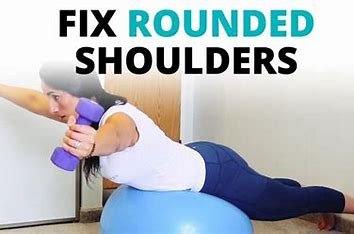
🏋️♂️ Exercises to Strengthen the Upper Back:
1. Rows
Muscles worked: Rhomboids, trapezius, lats, rear deltoids (upper back)
How to do it:
- Sit or stand with a straight back, holding a pair of dumbbells, resistance bands, or a cable machine.
- Pull the weights or bands toward your torso, squeezing your shoulder blades together.
- Focus on bringing your elbows straight back, not outward, to really target the upper back muscles.
- Reps: 3 sets of 10–12
Benefits:
- Rows target the muscles responsible for pulling the shoulders back, which is key for correcting rounded shoulders.
- Strengthening these muscles helps realign the shoulders and improves posture.
2. Reverse Flys
Muscles worked: Rear deltoids, rhomboids, traps
How to do it:
- Stand with your knees slightly bent, holding dumbbells in each hand.
- Hinge forward at the hips, keeping your back flat and your chest open.
- With a slight bend in your elbows, raise your arms out to the sides, squeezing your shoulder blades together.
- Slowly lower the weights back down.
- Reps: 3 sets of 10–12
Benefits:
- Reverse flys help activate the rear deltoids and upper back muscles, which pull the shoulders into a more neutral position.
- This exercise promotes scapular retraction, which is essential for improving posture and relieving tension from the chest.
3. Face Pulls
Muscles worked: Upper traps, rhomboids, rear deltoids
How to do it:
- Set a rope attachment on a cable machine at upper chest level.
- Grasp the rope with both hands, palms facing each other.
- Pull the rope toward your face, separating your hands and squeezing your shoulder blades together.
- Keep your elbows high and wide to really target the upper back.
- Reps: 3 sets of 12–15
Benefits:
- Face pulls work on strengthening the upper back, particularly the muscles that support the shoulders and help them stay in a more natural, neutral position.
- This exercise also targets the rotator cuff muscles, which contribute to shoulder stability.
🧘♀️ Stretching the Chest to Relieve Tension:
1. Chest Stretch (Doorway Stretch)
How to do it:
- Stand in a doorway with your arms raised to 90 degrees and elbows bent at 90 degrees.
- Place your forearms on the doorframe and gently step forward, feeling a stretch across your chest.
- Hold for 20–30 seconds, and repeat 2–3 times.
Benefits:
- This stretch helps open up the chest muscles, which tend to become tight when the shoulders are rounded forward.
- It helps counterbalance the forward pull of the chest, allowing your shoulders to realign.
2. Pec Stretch (Lying on a Foam Roller)
How to do it:
- Lie on your back with a foam roller placed horizontally under your upper back, extending along your spine.
- Let your arms fall out to the sides, palms facing up, and relax into the stretch.
- You should feel a stretch across your chest and the front of your shoulders.
- Hold for 20–30 seconds, and repeat 2–3 times.
Benefits:
- This stretch targets the pectoral muscles, which can become tight from poor posture or long periods of sitting.
- It helps to open up the chest and relieve the tension that contributes to rounded shoulders.
🧠 Pro Tips for Correcting Rounded Shoulders:
- Mind your posture: Be conscious of your posture throughout the day. Keep your shoulders back and your chest open. When sitting, use a chair with good lumbar support, or try a standing desk if possible.
- Stretch throughout the day: Even if you’re doing exercises to strengthen the upper back, make sure you also take time to stretch your chest and shoulders during the day to relieve tightness.
- Strengthen the core: A strong core helps maintain overall body alignment and supports proper posture. Exercises like planks, dead bugs, and bird-dogs help build core strength, which further aids in correcting rounded shoulders.
- Regular practice: Improving posture takes time and consistency. Aim to do your back-strengthening exercises 2–3 times a week and incorporate chest stretches daily.
